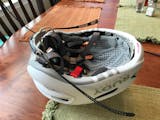Contacts or Prescription Sunglasses for Running or Cycling?

Wearing Contacts
PRO
For the best vision possible, nothing beats contacts. They offer better peripheral vision than glasses and more clarity at night since streetlights, car lights, and such don’t glare off the lenses. Even with the same prescription, contacts deliver superior vision over glasses. Today’s contact lenses are thinner, more breathable, and less costly than ever. Additionally, a set of daily contacts, ones where you put on a new pair each day, significantly reduces the risk of eye infections.
But from a performance standpoint, the top benefit of contacts is that users can wear any type or style of sports sunglasses. Goggles, too. They can wear frames with swappable lenses to dial in the perfect lens color for conditions: darker lenses for bright, sunny days; lighter lenses for overcast days. And let’s not forget that contacts don’t fog up from high humidity, sweat, or rain. That’s a big plus.
CON
Even wearing sports sunglasses, your eyes can still get dust in them. So you’ll need to carry eye drops to flush out any irritants. Also, contacts can lead to dry eyes, especially in cold or windy conditions, requiring a steady dose of eye drops to keep them lubricated. In addition to eye drops, you’ll want to carry spare lenses in case the contacts in your eyes get so dirty and irritating that you have to discard them and swap in a fresh set.
Contacts can also be problematic during allergy season, when pollen makes your eyes itch and occasionally leads to annoying conditions like allergic conjunctivitis, an inflammation of the lining inside your eyelid.
Wearing Prescription Sports Sunglasses
PRO
Advances in lens technology make it possible to wear prescription sunglasses for running, cycling, and all sports without compromising quality, comfort, or performance. Lightweight frames, full peripheral protection, high-quality optics, and various lens color choices — prescription sunglasses offer them all. Drop-in lenses such as Rudy Project’s Optical Docks and Optical Inserts allow even those with the strongest prescriptions to wear Rx sports glasses without sacrificing protection or sharper optics.
Prescription sports sunglasses can handle bifocal prescriptions for both far- and near-sightedness. They can even handle progressive lenses for prescriptions that require more than two corrections. Contacts can’t do that, which means that for some athletes, Rx sunglasses are really the only option.
CON
Sweat, humidity, and moisture will cause glasses to fog up, although Rudy Project sunglasses are designed to minimize or eliminate fogging. Treating the lenses with an anti-fog application can help, but it won’t guarantee fog-free glasses all the time. Unless you carry your everyday glasses with you, you’re stuck with your sunglasses to see in the fading light of dusk, while running through a dark tunnel, or anytime you want to head indoors. However,this issue is easily addressed with Rudy Project’s ImpactX photochromic lenses that change from light to dark based on varying light conditions.
You may need to buy and keep a spare pair of glasses on hand in case you lose your prescription glasses or break them in a fall or crash. That’s expensive. Another consideration that can be pricey? Needing to buy new glasses if your prescription changes. With contacts, you won’t bear the additional cost of new frames and lenses.
Whether you opt for contacts, prescription sunglasses, or a hybrid solution that uses both, the most important thing is that you can always see the road ahead as clearly as possible. Find the lens strategy that works for you — and your budget — and head out knowing you’re ready for every ride.









